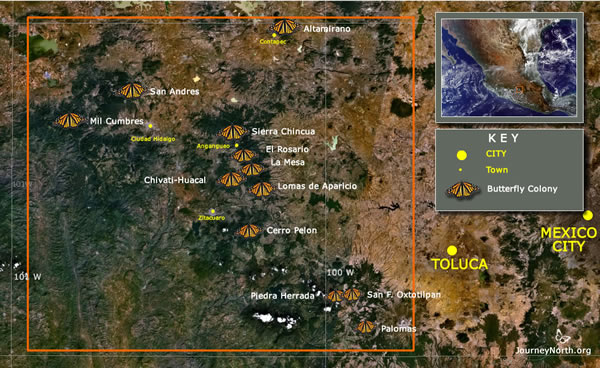Letter from Estela
El Rosario Sanctuary
El Rosario | Sierra Chincua
The end of the season at El Rosario Santuary.
Hands on our Hearts as We See They've Left April 3, 2017 Dear Friends, After a few weeks now actually observing a slow, gradual massive leaving, but having been in Sierra Chincua last Saturday April 1st. seeing that a good portion of the population was still remaining, I found it urgent to drive up to El Rosario to observe the behaviour of the Colony there, since in spite of the considerable population remaining both at the woods behind “Llano de los Conejos” and the woods in “Las Balsitas” sites last Tuedsay, there might have been some important relocations after a few days now! I decided, on purpose, to drive up to “El Rosario” at the start of the rather late afternoon, in order to observe the Colony’s actual population as late as possible, once most Monarchs would be back to the woods after their flying around, nectaring and drinking of the day. As I drove up, under the wonderful and rather very warm sunny day, I could notice how terribly dry the season is turning out, being now time for most local families to come to the end of the sowing days in their lands and surely wishing that the raining season will start as soon as possible by mid-end May as usual in our region, otherwise their crops may go dry and get lost, seen the dryness of the soil by the hot and dry weather so far. As I reached the entrance of the Sanctuary, I did notice this had been indeed the last official day for El Rosario Sanctuary too, as it had been announced the previous days; most restaurants and souvenir stands were now closed, and the few left open, were now starting to pack their left merchandises and belongings. I hurried up the stairway into the Colony, and could see still some Monarchs nectaring here and there at the “Hoja Ancha” yellow flower. As I reached the “Llano de los Conejos”, I could see even some more nectaring and flying around at one or two other kinds bushes around there. I hurried into “Las Balsitas” woods first, sure that the colony was still there and noisy about its status today. As soon as I reached the site at a jogging pace, excited to see them, my jogging slowed down as if getting slowly frozen at the very silent and quiet impression around. The site was now totally deserted. Hardly a few Monarchs could be seen around either flying or at the tip of an Oyamel branch indeed being these their last moments at their overwintering site. As I walked slowly turning around and peeping into other areas of the woods still hopeful to see some small concentration or tiny clusters, I could see how rather scarce the perishing in the ground was; --predators have indeed been very active, I thought to myself--. One or two small ponds or streams found in the way looked now cleared out with not even trace of dead bodies of Monarchs around them. When I was about the leave the area, two local forest guards came up and asked me whether I was already leaving the site:
Then I felt there was not a minute to loose and went back my way to the “Llano de los Conejos”, thinking a small portion of Monarchs might be still there, since it all seemed the massive leaving had been occurring during the last 48 hours at the most. I could hardly count 3-5 Monarchs flying up high in the sky at the “Llano de los Conejos” woods. Every single tree was totally back to looking beautiful naked green. To my very empiric learning, the perishing all over the soil was perfectly normal in quantity and conditions according to the very important population there up to only five days before. Outside by the bushes at the “Llano de los Conejos”, at some humid areas, I caught two to three Monarchs drinking some water at a very humid area. Incredibly lucky to be the very last one up there at the Monarchs’ overwintering forests this last afternoon in the season, my brain rewinded memories back to the days exactly one year before, where I standing by myself in this very site at “Llano de los Conejos”, witnessing the terrible tragedy of Monarchs’ perishing at the hitting of the bad wind, hail, snow and ice storm the year before. I felt privileged to be the one to have the chance to bid my very humble act of veneration for the chance to witness, one more season, one more miracle of the Monarch of all butterflies, and of the unimaginable and extraordinary efforts of so many people and organizations, who have indeed once more contribute to it. Back at leaving the Sanctuary, an atmosphere of sadness and nostalgia prevailed among the personnel still getting ready to close facilities everywhere. I could still thank some of the Ejidatarios there and shared the last moments with some children working up to the very last hours of the day, like Lupita, Susana, Mario and Mauricio, who immediately recognized me and with a sad and rather loud voice, told me:
I kept silent feeling myself silly at not being able to find response in my mind storage at the surprising reasoning of these children. Cornelio, a boy waiting for his parents to close their restaurant, told me:
I dared to respond to the little boy:
I quietly started my loyal car, Rocinante, both congratulating each other, my car and me, for sharing this one more wonderful season together. Until next fall when I report to you again, I remain, Estela Romero
|
|
||||||||||||||||
Copyright Journey North (journeynorth.org). All Rights Reserved.







